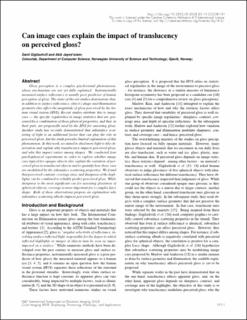| dc.contributor.author | Gigilashvili, Davit | |
| dc.contributor.author | Jayed Islam, Akib | |
| dc.date.accessioned | 2024-03-08T12:38:14Z | |
| dc.date.available | 2024-03-08T12:38:14Z | |
| dc.date.created | 2024-01-14T07:08:37Z | |
| dc.date.issued | 2023 | |
| dc.identifier.citation | IS&T International Symposium on Electronic Imaging Science and Technology. 2023, 35 (15), 191-1-191-6. | en_US |
| dc.identifier.issn | 2470-1173 | |
| dc.identifier.uri | https://hdl.handle.net/11250/3121594 | |
| dc.description.abstract | Gloss perception is a complex psychovisual phenomenon, whose mechanisms are not yet fully explained. Instrumentally measured surface reflectance is usually poor predictor of human perception of gloss. The state-of-the-art studies demonstrate that, in addition to surface reflectance, object's shape and illumination geometry also affect the magnitude of gloss perceived by the human visual system (HVS). Recent studies attribute this to image cues – the specific regularities in image statistics that are generated by a combination of these physical properties, and that, in their part, are proposedly used by the HVS for assessing gloss. Another study has recently demonstrated that subsurface scattering of light is an additional factor that can play the role in perceived gloss, but the study provides limited explanation of this phenomenon. In this work, we aimed to shed more light to this observation and explain why translucency impacts perceived gloss, and why this impact varies among shapes. We conducted four psychophysical experiments in order to explore whether image cues typical for opaque objects also explain the variation of perceived gloss in translucent objects and to quantify how these cues are modulated by the subsurface scattering properties. We found that perceived contrast, coverage area, and sharpness of the highlights can be combined to reliably predict perceived gloss. While sharpness is the most significant cue for assessing glossiness of spherical objects, coverage is more important for a complex Lucy shape. Both of these observations propose an explanation why subsurface scattering albedo impacts perceived gloss. | en_US |
| dc.description.abstract | Can image cues explain the impact of translucency on perceived gloss? | en_US |
| dc.language.iso | eng | en_US |
| dc.publisher | Society for Imaging Science and Technology | en_US |
| dc.relation.uri | https://doi.org/10.2352/EI.2023.35.15.COLOR-191 | |
| dc.rights | Navngivelse 4.0 Internasjonal | * |
| dc.rights.uri | http://creativecommons.org/licenses/by/4.0/deed.no | * |
| dc.title | Can image cues explain the impact of translucency on perceived gloss? | en_US |
| dc.title.alternative | Can image cues explain the impact of translucency on perceived gloss? | en_US |
| dc.type | Peer reviewed | en_US |
| dc.type | Journal article | en_US |
| dc.description.version | publishedVersion | en_US |
| dc.source.pagenumber | 191-1-191-6 | en_US |
| dc.source.volume | 35 | en_US |
| dc.source.journal | IS&T International Symposium on Electronic Imaging Science and Technology | en_US |
| dc.source.issue | 15 | en_US |
| dc.identifier.doi | 10.2352/EI.2023.35.15.COLOR-191 | |
| dc.identifier.cristin | 2225915 | |
| dc.relation.project | Norges forskningsråd: 288187 | en_US |
| cristin.ispublished | true | |
| cristin.fulltext | postprint | |
| cristin.qualitycode | 1 | |

